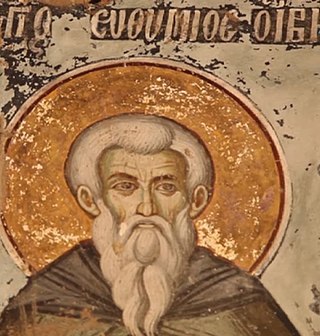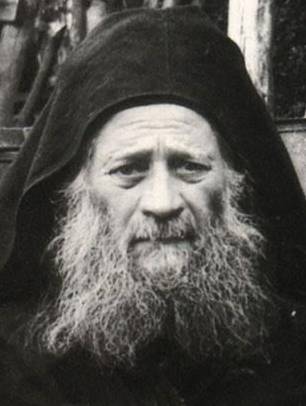Simon the Athonite (died 1287) was an Orthodox monk of the 13th century, later sanctified by the Eastern Orthodox Church as Saint Simon the Myroblyte .
Contents

Simon the Athonite (died 1287) was an Orthodox monk of the 13th century, later sanctified by the Eastern Orthodox Church as Saint Simon the Myroblyte .

Simon's date of birth is uncertain, but he has been described as being of the second half of the thirteenth century, [2] and the monastery's records state that he died in 1287. However, the British Museum adventurously suggests his life as c. 1200 to c. 1300. [3]
Simon was a hermit living in a cave on Mount Athos near the rock now known as Simonopetra, or Simon's Rock. In a dream, the Theotokos called on him to build a monastery on the rock, promising to protect it and to look after him and the monastery. Another version is that one night he saw a star so bright that he identified it with the Star of Bethlehem. Watching it over several nights, he saw it stay motionless, at first thinking it was a demonic temptation, but on Christmas Eve the star stood over a high rock and a voice said "Here, Simon, you must lay the foundations of your monastery for the salvation of souls." So he built the monastery and gave it the name of New Bethlehem (Greek: Νέα Βηθλεέμ). [4] It remains dedicated to the Nativity of Jesus.
Simon died, or reposed, in 1287, and was later glorified by many miracles, leading to his beatification. His holy relics are reported to exude myrrh, giving him the alternative names of Myrrhbearer or Myrrhgusher. [4]
The date of foundation claimed by his monastery is 1267. [5]

July 11 - Eastern Orthodox Church calendar - July 13

August 15 - Eastern Orthodox liturgical calendar - August 17

The Sacred Patriarchal and Stauropegic Monastery Esphigmenou is an Eastern Orthodox monastery dedicated to the Ascension of Christ in the monastic state of Mount Athos in Greece. It is built next to the sea at the northern part of the Athonite peninsula. Located near the Hilandar monastery, it is the northernmost of all Athonite monasteries. The current monastery dates back to the 10th century, while tradition holds that the site had been used as a monastery since as early as the 5th century. Esphigmenou ranks eighteenth in the hierarchy of the Athonite monasteries and since the early 1970s has been embroiled in legal and ecclesiastical disputes. It is considered amongst the most conservative of the monastic houses on Mount Athos.

Athanasius the Athonite, was a Byzantine monk who is considered the founder of the monastic community on the peninsula of Mount Athos; which has since evolved into the greatest centre of Eastern Orthodox monasticism.

Euthymius the Athonite was a Georgian monk, philosopher and scholar, who is venerated as a saint. His feast day in the Orthodox Church is May 13.

Simonopetra Monastery, also Monastery of Simonos Petra, is an Eastern Orthodox monastery in the monastic state of Mount Athos in Greece. It ranks 13th in the hierarchy of the Athonite monasteries.

Pantokratoros Monastery is a Greek Orthodox monastery in the monastic state of Mount Athos in Greece. It stands on the north-eastern side of the Athos peninsula, and is dedicated to the Transfiguration of Our Lord. The monastery ranks seventh in the hierarchy of the Athonite monasteries.

Stavronikita Monastery is an Eastern Orthodox monastery at the monastic state of Mount Athos in Greece, dedicated to Saint Nicholas. It is built on top of a rock near the sea near the middle of the eastern shore of the Athonite Peninsula, located between the monasteries of Iviron and Pantokratoros. The site where the monastery is built was first used by Athonite monks as early as the 10th century. Stavronikita was the last to be officially consecrated as an Athonite monastery in 1536 and ranks fifteenth in the hierarchy of the Athonite monasteries. It currently has 30 to 40 monks.
Paisios of Mount Athos, was a well-known Greek Eastern Orthodox ascetic from Mount Athos, originally from Pharasa, Cappadocia. He was respected for his spiritual guidance and ascetic life. Today, he is widely venerated by Eastern Orthodox Christians, particularly in Greece, Russia and Syria.

Peter the Athonite is reputed to have been the first hermit to settle upon the Mount Athos.

October 25 - Eastern Orthodox liturgical calendar - October 27
Niphon of Kafsokalyvia or Niphon Kausokalybites was a Greek Christian Orthodox saint and monk. He is celebrated by the Eastern Orthodox Church on June 14.

December 4 - Eastern Orthodox liturgical calendar - December 6

December 6 - Eastern Orthodox liturgical calendar - December 8

December 27 - Eastern Orthodox liturgical calendar - December 29
This is a timeline of the presence of Eastern Orthodoxy in Greece from 717 to 1204. The history of Greece traditionally encompasses the study of the Greek people, the areas they ruled historically, as well as the territory now composing the modern state of Greece.

The monastic community of Mount Athos is an Eastern Orthodox community of monks in Greece who hold the status of an autonomous region as well as the combined rights of a decentralized administration, a region and a municipality, with a territory encompassing the distal part of the Athos peninsula including Mount Athos. The bordering proximal part of the peninsula belongs to the regular Aristotelis community in Central Macedonia.

Joseph the Hesychast was a Greek Orthodox monk and elder who led a small group of monks at Mount Athos. He was canonized as a saint by the Ecumenical Patriarchate of Constantinople in 2020. His annual feast is celebrated on August 16.
Saint Daniel Katounakiotis of Smyrna was a Greek Orthodox monk who lived on Mount Athos. He was canonized as a saint by the Ecumenical Patriarchate of Constantinople in 2020. His feast is commemorated on September 7.
Saint Nilus the Myrrh-streamer, also known as Nilos/Nilus the Myrrh-gusher, Nilus of Kynouria, or Nilus the Myroblyte, was an Orthodox Christian ascetic who lived at Mount Athos. He was a monk at the Monastery of Great Lavra who spent much of his life as a hermit at the southern tip of the Athos Peninsula.